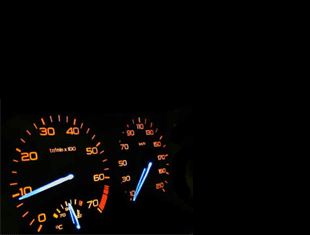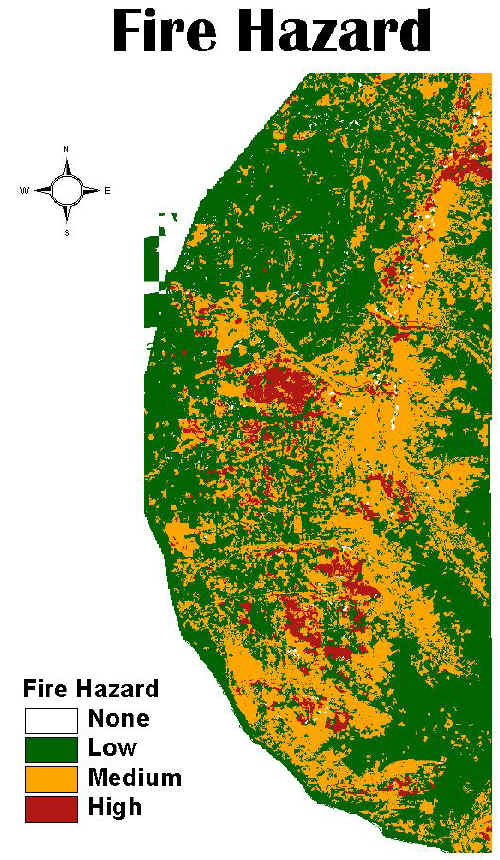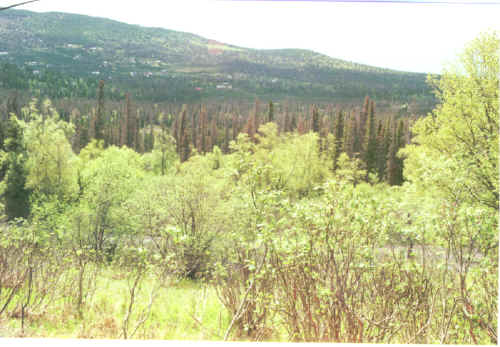- Mixed hardwood and conifer forests that burn readily.
- Infestation of the spruce bark beetle, which kills spruce trees, leaving behind dead standing and fallen trees that contribute to extreme fire behavior. In the MOA greater area, 85,000 acres in wildland/urban interface areas have been affected by the spruce bark beetle epidemic.
- It may take rescue workers one hour or more to reach wildfires due to the large distances that must be covered.
- Lack of water supply in the Eagle River Valley, South Fork, South Anchorage Hillside and other sites.
- Limited access to suppression resources and evacuation routes in many MOA communities.
- Hilly topography of the MOA, which contributes to rapid fire spread.
- Dry foliage and dead grass during Alaska's dry spring season.

The MOA contracted IGIS Technologies (IGIST), Inc.(San Diego, Calif.) to classify vegetation and forest fuel structure and develop spatial models that produce relative fire risk maps.
IGIST put together a team consisting of one image processing specialist, a forest ecologist and a GPS field technician familiar with the local terrain and vegetation.They began the project by running a classification that defined and labeled general vegetation and other land cover using a Landsat TM image of Anchorage taken in 2000. IGIST conducted unsupervised classification schemes on the study area using the ERDAS IMAGINE® geographic imaging software.
Data from multiple resolutions was used to determine class labels: 1-meter aerial photographs, 4-meter IKONOS, 50-meter U.S.Geological Survey (USGS) land cover, and GPS transects adjacent to the classified imagery.Each class was labeled with the most appropriate land cover in conjunction with the advice of the GPS field technician.
IGIST determined data inputs and created a spatial model that included seven key weight inputs with direction from MOA, Department of Natural Resources, and Anchorage Fire Department personnel.The seven key weigh inputs included: vegetation classification, slope, aspect, spruce beetle kill areas, distance to roads, distance to nearest water source and population density.
Next, the analysts combined these seven components within the IMAGINE Spatial Modeler tool, which allows analysts to quickly create complex, reusable geospatial models through the use of a graphical interface to build a flowchart of inputs, functions and outputs from related components. In the final output, each component was assigned a low, moderate or high fire risk weight.For example, if an infested area is close to water, it was given a low fire risk weight.If it was far away from water, it was given a larger weight, meaning the area had a moderate to high fire risk.
"The fire risk model generates outputs that allow the MOA to take a systematic approach to fire fuel mitigation, long-range planning and public awareness," said Arman Eshraghi, Image Analyst, IGIST."This is part of our effort to emphasize that GIS analysis should ultimately be used for decision support."
The Alaska DNR Division of Forestry added an important component to the project with FARSITE, a GIS-based program that simulates growth and behavior of both point-source fires (starting at a small, confined spot, such as a lightning strike) and line-source fires (fires that have become large and out-of-control) as they spread through different terrain under changing weather conditions.
They incorporated vegetation layers to create a preliminary workflow of FARSITE.With the field data gathered by a University of Alaska graduate student, the Division of Forestry and the Anchorage Fire Department are developing a fuel model that can accurately characterize spruce bark beetle-affected areas.(Fuels include grass, shrub or timber that escalate the threat of wildfire).Personnel will continuously analyze and manipulate the data to help develop fire behavior models that best represent forestland conditions in the Municipality.
Results from FARSITE can be used to assist in reviewing fire evacuation routes and determine if they're located in safe areas where prevailing winds will not carry wildfires towards these routes and impede evacuation efforts.Urban forest areas, such as city parks and open spaces, can also be managed.This is an important accomplishment, as these areas have largely been ignored in the past because they typically don't get enough money for maintenance.This project identifies areas that need attention, allowing the Division of Forestry to manage them more effectively so the public can use these lands for recreational purposes.
The vegetation layers created by IGIST provided a starting point for determining fire risk in individual neighborhoods.As additional data is gathered and fire risk maps are created, the Anchorage Fire Department will specifically target high-risk areas, enabling them to focus their funding and manpower where it is most needed.Through this project, the Anchorage Fire Department is developing the foundation needed to continue efforts to reduce wildfire risk.
Land cover classification, fire behavior modeling and map creation made up Phase I of the project, which is now complete.Phase II, which involves refining the spatial model developed in Phase I; collecting additional wildland/urban interface data for neighboring Girdwood and Eagle River; developing a mobile PDA ESRI ArcPad application for mapping wildfires and transmitting the maps via wireless technology to the MOA's emergency operations center; and developing an application that integrates FARSITE application outputs into the Municipality's GIS database, is currently underway.
Forest structure changes over the years and fuel treatments performed by the Anchorage Fire Department will impact the Municipality's fire risk maps.Over time, MOA will obtain sharper images and more complete data and repeat the steps of this project to ensure they always have the most accurate information needed to minimize wildfire threat to human life, property, and natural resources.The most accurate results will be integrated into an emergency preparedness program, which includes wildfire mitigation activities, fire suppression tactics, evacuations, and safety zone identification. The program will be made available to public and private landowners and agencies via the Web, public presentations and brochures.
"GIS has great applicability for a wildfire mitigation project, because it provides a clear explanation and methodology for estimating wildfire risk on a variety of scales, down to the parcel or structure level," said Charlie Barnwell, Manager, Data/GIS Resources Department, MOA."
As a part of its ongoing effort to be as educated and prepared for the threat of fire as possible, the MOA is a member of Firewise Communities, a national partnership of public agencies that promote fire preparedness in communities across the country.Through presentations and workshops, community leaders and professionals learn to prepare for and protect communities from the effects of wildland fire by recognizing wildfires, designing Firewise homes and landscapes, educating the public and incorporating Firewise planning into existing and developing areas of communities.
For more information about the Municipality of Anchorage, visit: www.muni.org.
 Figure 1: The IMAGINE Viewer shows the process of unsupervised classification.
The images on the right were used to help label different class types of
the left image.
Figure 1: The IMAGINE Viewer shows the process of unsupervised classification.
The images on the right were used to help label different class types of
the left image.

Figure 2: This land cover classification output shows the low,
moderate and high fire risk areas in the Municipality of Anchorage (MOA).
 Figure 3: Dead spruce cause a major fire hazard to the Alaskan landscape.
MOA personnel are using GIS to lessen the threat of wildfires.
Figure 3: Dead spruce cause a major fire hazard to the Alaskan landscape.
MOA personnel are using GIS to lessen the threat of wildfires.
All images courtesy of IGIS Technologies, Inc.
ERDAS IMAGINE is a registered trademark of Leica Geosystems GIS & Mapping, LLC.All other product names are properties of their respective owners.Leica Geosystems GIS & Mapping retains all intellectual property of this article.